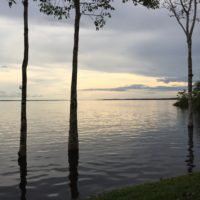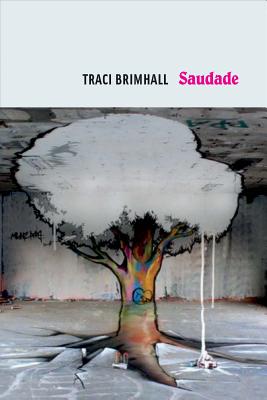[Inspired by stories from her Brazilian-born mother, Traci Brimhall’s third collection Saudade (Copper Canyon Press, November 2017)—a lush and startling “autobiomythography”—is reminiscent of the rich imaginative worlds of Latin American magical realists. Set in the Brazilian Amazon, Saudade is one part ghost story, one part revival, and is populated by a colorful cast of characters and a recurring chorus of irreverent Marias.
In Brazil, the day of Saudade is officially celebrated on January 30. – Ed.]
***
When I started writing a book about my mother, she was alive. Even though I set my poems in the Amazon, in the same town my mother was from, I maintained they were not about her. I claimed all I’d taken from her was the location from which my imagination springs. I said I wasn’t interested in telling a story about her, even though the poems borrowed facts from her life and exaggerated them to the point of myth. Of course, Oscar Wilde said “where there is no exaggeration, there is no love,” so perhaps the book is about my mother. I’d like to maintain that both statements are true.
Here’s a true story: my mother cut firewood with a machete. One day she didn’t pay close enough attention to where her fingers were next to the wood and mostly severed her middle finger. It was tightly wrapped and she was canoed upriver to a doctor who stitched it back and it healed whole, miraculous. When I was a child, this story held such drama—a child in peril, a terrible accident, a race against time, blood loss, and journey through a difficult landscape. Through love and a healthy does of exaggeration, it became a poem about a severed hand that became animate and started performing miracles and curses of its own volition, everything from curing diseases to writing poems on trees.
An accident chopping firewood became a myth about the blessing and curses of a dismembered hand. My mother’s scar and her story suggested another more mysterious kind of miraculous accident. Accidents are unexpected, like the best moments in poems, though it’s hard to prepare for an accident; sometimes you have to wait for them to find you. When I wrote the first poem that would become a part of this book in the summer of 2011, I had a story and a plan. The plan had little or nothing to do with my mother at the time. Though I knew I was using the setting of her childhood, I was also carrying around the voice of Emily Dickinson in my head, the voice that said: “Nature is a haunted house. Art is a house that tries to be haunted.” I wanted to move my ghosts into someone else’s house, so I chose my mother’s house and Fernando Pessoa’s gift for hiding in plain sight.
“I am neither man nor woman, because no one thinks I’m anything,” wrote Maria José, the consumptive, hunchbacked nineteen-year-old heteronym of Fernando Pessoa. Pessoa wrote poetry, prose, and letters to himself under many heteronyms, but Maria José was his only female heteronym and she only wrote one letter. Her epistle is fairly brief and narrates her love for António and the few moments of interaction they had while she gazed down at the street from her window. When this inactive witnessing became too dispiriting and she tried to throw herself from the window, she discovered her fall was not high enough to take her life. The people who witnessed Maria José’s unsuccessful attempt at self-annihilation laughed. Her suffering was on display where she sat by her window, able to see everyone passing by, but also exposed to their judgment, their ridicule or, worse, their indifference. Part of what fascinated me about Pessoa’s choice of Maria José as a heteronym in particular was that she represented his singular departure in gender among all his identities, but where I saw my own obsessions intersecting with Pessoa’s work was in Maria José’s body, and in Pessoa’s choice to assail his persona in multiple bodily ways—arthritic legs, consumption, kyphosis. Decapitation, dismemberment, scars, and other woundings continually show up in my own poems.
The poem I wrote in the summer of 2011, in which I abducted Maria José from her window and took her to Brazil, was a failure. It had its good lines and moments, but it was like an exciting first date in a familiar and boring place—where it led was interesting, but the event of the poem itself was valuable mostly because of what it foreshadowed. It also introduced some of my ghosts—a narcissistic god, a disillusioned love, a lost child—to their new house in the Amazon. Failures can come out of great and forceful intention, but they’re also often accidents. In his essay “Words Into Feeling,” Seamus Heaney writes:
a poem always has elements of accidents about it, which can be made the subject of inquest afterwards, but there is always a risk in conducting your own inquest. You might begin to believe the coroner in yourself rather than put your trust in the man in you who is capable of the accident.
Even though the poem failed, I stole what was best of it in an attempt to make something of that first impulse—that first migration of ghosts—survive in the final draft.
While my abduction of Maria José was intentional, the form her voice took was an accident of licentious literary play. Much like Maria José’s statement in her love letter to Senhor António that she is neither man nor woman, I first attempted to write this book in the form of the verse novel in order to be as promiscuous as possible with genre and refuse defined parameters. The word “hybrid” itself means to be mongrel, to be of different lineages. One of “hybrid’s” etymological roots is connected to hubris, that old challenge to the gods to punish presumptuousness in heroes. The genre classification of verse novel calls attention to itself by aligning its name and form with this hybrid dualism. It wants to belong and not to belong, to be counted among two genres and yet be neither, to be the offspring of both the tame and the wild, something altogether new.
Pessoa also seemed to have this desire to serve two masters and played with this notion of fictional memoirs in his “Factless Autobiography” in The Book of Disquiet. It is another exercise in what he called depersonalization, writing in another voice and calling it both autobiography and fiction. Though I never called this book an autobiography, I have called it an autiobiomythography when describing it, making my own similar claim to both truth and fabrication, since the poems are inspired by my mother’s life, other Brazilian literature, and my own wild invention.
But that was the version of the book that existed before my mother died. My mother’s death was not an accident, unless not having health insurance and doctors who misdiagnose is an accident. Her death brought me back to the Portuguese idea of saudade, an inexhaustible longing for a place or person. I knew my grief for my mother was a kind of saudade, a state of impossible longing I’d be in for the rest of my life. Singer and songwriter Nick Cave, in his essay “The Secret History of the Love Song,” said: “Saudade is the desire to be transported from darkness into light, to be touched by the hand of that which is not of this world.” And I realized the severed hand that kept appearing in the book wasn’t an accident. It was the desire for a revelation made manifest. It was the problem the book hadn’t contended with yet.
One way to consider order for a book of poems is to figure out what question it’s asking. I thought this book, with its evident ars poetica and extra-textual material, was asking the question: Where do the poems come from? And of course I thought I knew the answer—my mother’s childhood which taught me to imagine what she must’ve imagined, an actual time and place that had become myth through my invention.
When my mother died, I realized that was not the right question. Or at least it wasn’t the question I was interested in asking anymore. Now I wondered not where poems come from, and not even where I come from, but from whom? All of the voices surrounding the strange events of my poems suddenly were no longer chroniclers of a mystery, but a family. When I started putting poems in order, I started with the last poem in the town’s history and went backward chronologically. The book now begins with loss and reaches back through a coup d’état to a mother’s death, to shape-shifting dolphins seducing anyone in need of pleasure, to the end of the rubber boom and the flight from the richest city in the world, to that boom’s beginning and a rubber baron falling in love with an opera singer, because who can resist a coloratura in a green dress? Unspooling them backwards also means the book ends with a love story; the most hopeful answer to the question: Who do I come from?
A year after my mother died, I went back to the place she grew up. There I met a Canadian who said he always goes back to the Amazon every few years to matar as saudades, or kill the longing. Sometimes, something can be so close that you need to push it away in order to truly see it. Other times, the thing that feels so close is a place you’ve never been. My mother’s childhood in Brazil was always a source of fascination for me—the unfamiliar setting, the oddness of a life with such intimacy with animals, the words that existed for her in that country that had no correlation in my own childhood. I always asked questions about certain experiences or asked for certain stories to be told and retold, but an interesting life doesn’t make for interesting stories, and my mother was a terrible story teller. As a result, this place that I’d never seen and that was the backdrop of much of my early imagination began to populate itself with my own inventions. A myth is its own kind of truth. And maybe when I killed the longing, it wasn’t an accident but an invitation to ask a different kind of question, to tell a different story about who I am and what kind of love made me.
***
Photographs provided courtesy of author.







